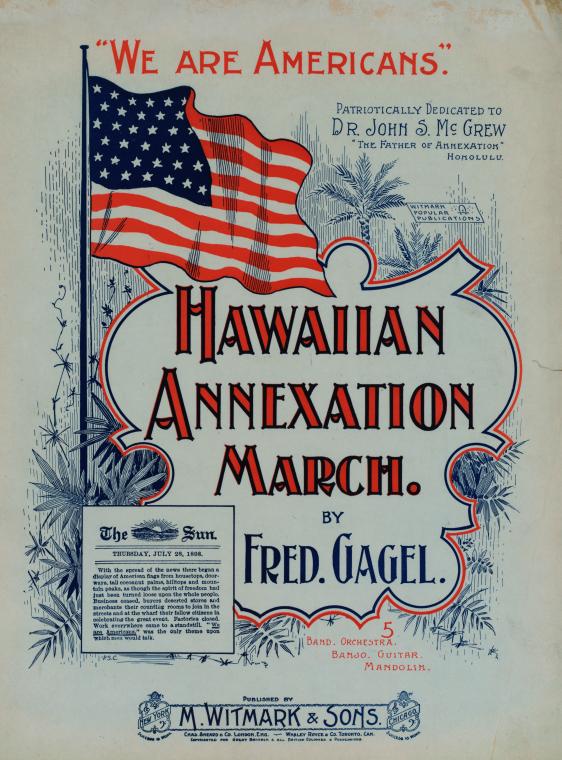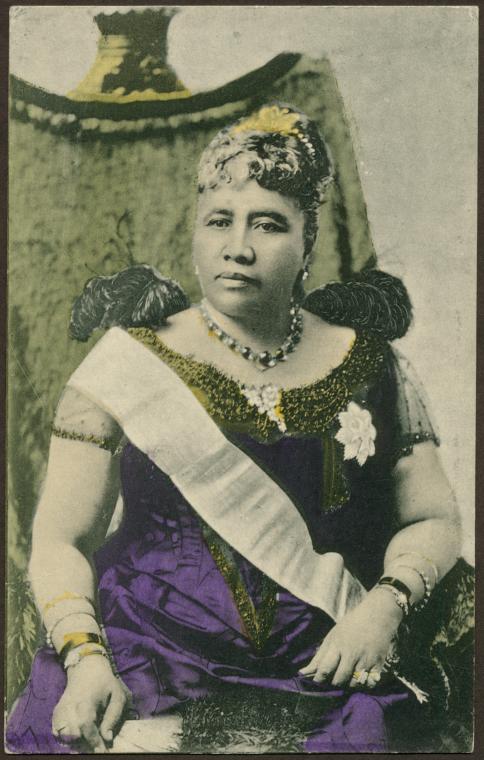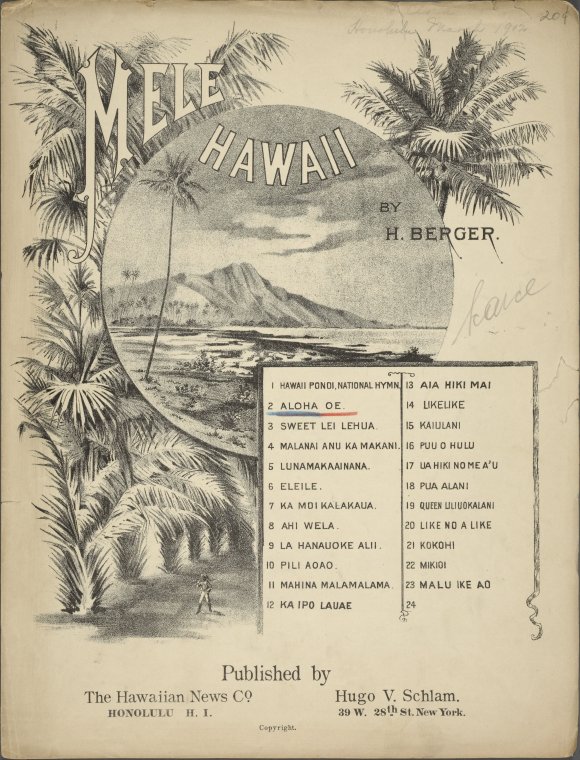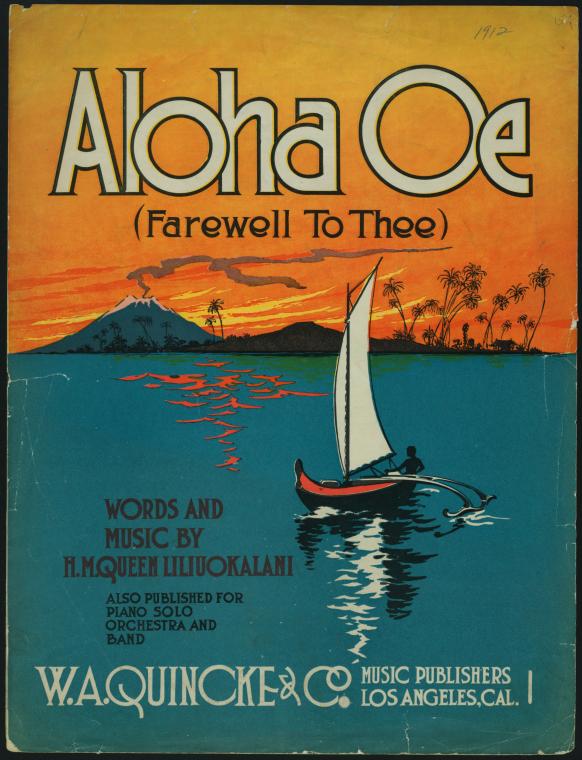Hawaiian Steel Guitar as Resistance Music: Tracing a Hidden History
This is a guest post by Tamar Barzel, PhD, written in partial fulfillment of a field work placement in Music Librarianship through Long Island University-Post's Palmer School of Library and Information Studies.

Music’s role in resistance movements has been playing out in the nation’s streets since last spring. Haitian drummers have energized protests in Brooklyn; hip hop songs, broadcast from movable PA systems, have had protestors singing along in unison; bandleader Jon Batiste has led thousands in musical marches. (As history shows, music can also unite people around corrosive causes such as "white power.") If music is galvanizing, it is also portable and shape-shifting. It can be stored away in memory and carried into new contexts, developing in new directions and picking up new associations. It still holds the power to entertain and inspire, but its role in fomenting resistance is forgotten.
In May, amid New York’s COVID-19 lockdown, the NYPL expanded access to e-books available from home, and I picked one up that I had been meaning to revisit. In Kika Kila: How the Hawaiian Steel Guitar Changed the Sound of Modern Music (University of North Carolina Press, 2016), John Troutman elucidates the history of the steel guitar, “a Native Hawaiian technology [that] generated the modern sounds of American popular music.” In the context of today’s protests, the book takes on added resonance. In its beginnings, steel guitar was resistance music. Its locus was Hawai‘i, and its mobilizing role came through local resistance to the usurpation of political power by (largely) American business interests in the 1890s—a coup that led to the overthrow of the Hawaiian monarchy, and that ultimately resulted in the annexation of Hawai‘i in 1959 as the 50th state in the union.
Steel guitar, Troutman writes, "upends common understandings of the most significant U.S. musical genealogies." The history of the instrument makes it plain that foundational aspects of American popular music are located in the innovations and actions of indigenous artists, who are in turn linked to indigenous histories. In fact, Hawaiian steel guitar and guitarists had a direct influence on that quintessential instrument in American popular music, the electric guitar. By charting the steel guitar’s genesis and its global circulation, Troutman goes some way toward ameliorating the erasure of Native people and Native music from received narratives about American music. Troutman’s playlist for Kika Kila, which illuminates steel guitar’s deep historical roots and wide influence, is available on Spotify.
Hawaiian music scholar Amy Ku‘Uleialoha Stillman calls mele, or poetic text, “the basis for Native Hawaiian performance.” (Hula is mele recitation accompanied by choreographed interpretive dance, with instrumental accompaniment.) By the 1860s, Hawaiians from the royal classes, educated in schools founded by Christian missionaries, were composing and publishing “mele Hawai‘i,” songs in the Hawaiian language, arranged for piano and voice and modeled after Protestant hymns and Victorian parlor songs. Queen Lili‘uokalani (1838–1917), who would ultimately be the last monarch of the Hawaiian Islands, published more than 100 such songs. Best-known today is “Aloha ‘Oe” (Farewell to Thee) (1884), a love song.
The two images below are from sheet music covers published in 1898 and 1912, and they suggest that the erasure of Native people from the American musical landscape was already well underway by that point. The first image depicts Hawai‘i as an unspoiled wilderness, with no sign of its Native inhabitants or Honolulu’s bustling harbor. Below it, the solitary figure wending its way in a sailboat toward the faraway Islands suggests a shift, as Hawai’i was marketed as a tourist destination for Americans, a beckoning escape to a pre-modern paradise.
At first glance, songs like these might seem part of the mechanism of imperialism, forcing Native Hawaiian ceremonial music into an American commercial frame. But Hawaiians had been masters of this kind of cosmopolitan musical mixing for decades, folding influences from outside the Islands into new genres that became inseparable from Hawaiian musical culture. (The ‘ukulele, for example, was modeled on the Madeiran machête and rajão, which Portuguese sailors brought to the Islands in the late 1800s.)
Guitars may have been introduced to Hawai‘i by American Indian and mestizo vaqueros, by New England missionaries or whaling ships, or by Hawaiians who encountered them in the early 1800s during a trip to California. Guitars were ubiquitous in the Islands by the late nineteenth century, played in homes, "strolling" string bands, glee clubs, churches, theaters, dance halls, labor camps, hotels, restaurants, and taverns. In the 1880s, as Americans were intensifying their efforts to usurp Hawaiian sovereignty, Hawaiians merged local guitar culture with hula culture to create hula ku‘i, "hula that joins old and new." With guitar and ‘ukulele accompaniment, hula ku‘i drew on Native poetic idioms while incorporating new dance movements and mele. Hawaiian-language newspapers published hundreds of original mele texts sent in by readers supporting the anti-annexationist Hawaiian cause. In the context of a legal ban on hula performance, hula ku‘i, with its striking cultural blend, defied imperialist efforts to relegate Hawaiian culture to the past.
Hula ku‘i was not the only innovative kind of expressive culture to emerge in the era’s charged political atmosphere. Steel guitar, which featured prominently at "royalist" Hawaiian nationalist rallies, was named for the rounded metal bar the performer used to produce otherworldly swoops and cries on the instrument, which was fitted with a raised nut (the strip on the guitar neck that elevates the strings), strung with steel strings rather than gut, and laid flat on its back. Joseph Kekuku, a young guitarist who supported the royalist cause, has been recognized as the key visionary, a self-taught virtuoso on an instrument he envisioned and perfected. A new instrument, a new playing technique, and a new sound: taken together, steel guitar, with its unmistakably Hawaiian sound, emerged as a new "technology" for building Hawaiian solidarity and celebrating Hawaiian voices, in defiance of ongoing efforts to silence them both.
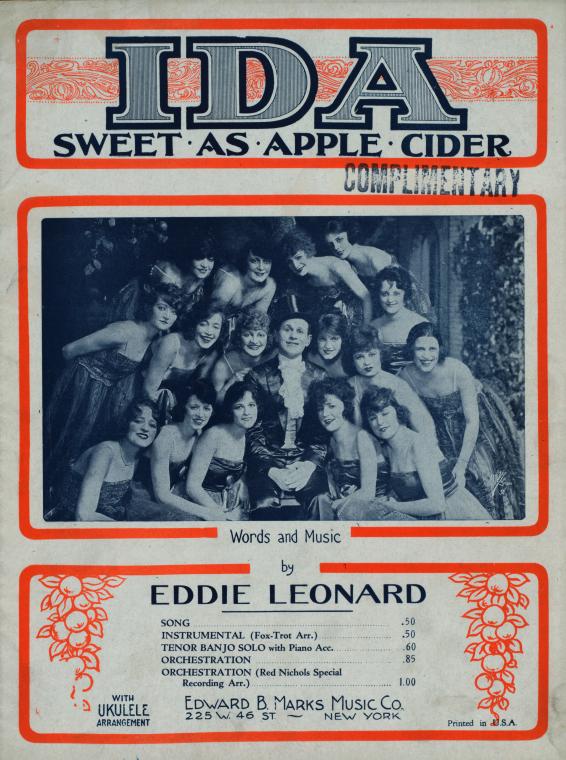
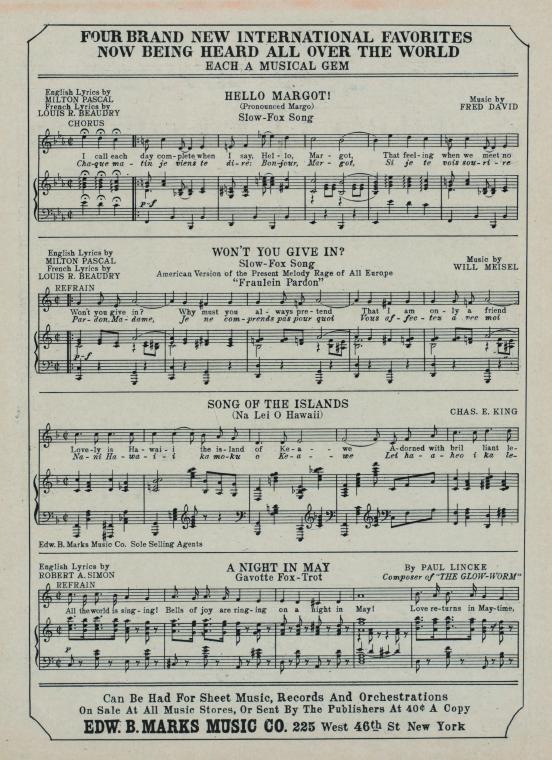
By the early 1900s, with the monarchy deposed and the old order displaced, Hawaiian musicians, including Kekuku, were leaving the Islands to seek out new opportunities. Where steel guitarists went, a surge in popularity followed. Audiences on the mainland did not link the instrument to the anti-imperialist cause. Instead, steel guitar became synonymous with Hawai‘i in the American musical imagination.
Helped by performances in San Francisco at the Panama-Pacific Exposition in 1915 and by a burgeoning market for sheet music and 78 rpm shellac records, by 1916 Hawaiian records were outselling all other categories. Steel guitar schools flourished, and Hawaiian artists made careers playing Hawaiian music and writing songs with Hawaiian lyrics, while also looking for ways to expand their creative horizons.
Hawaiian music remained ubiquitous in mainland popular culture even as the recording and sheet music industries wove imperialist fantasies around it. By the 1930s, a generic Polynesian-themed club scene was booming in California and New York City, a double-edged sword that provided artists with steady work while requiring them to perform to racial “type” in order to offer audiences the ethnic novelty they had paid for.
It is around this time that Troutman locates the beginning of the disappearance of "Hawai‘i" from narratives about American music. The instrument’s associations with Hawaiian music and musicians continued to recede as the recording industry embraced a bipartite racial marketing model for the musical region that had begun to command public attention, and that would ultimately transform the global musical landscape—the American South.
Hawaiian songs from the 1920s and 1930s might seem like relics of an earlier era that were bound to fade from public memory. But the erasure of Hawaiian history from the American musical narrative comes into plainer view with the understanding that it was Hawaiian steel guitarists in search of more volume who drove the development of the National ("Dobro") resonator guitar in Los Angeles, followed by the first successfully mass-produced electric guitar, the Rickenbacker Electro A-22 "frying pan" in 1932. Sol Ho‘opi‘i, the nationally recognized star of L.A.’s Hawaiian guitar scene, served as leading endorser for both instruments.

Without diminishing the foundational role played by (African American) blues and (white) country/bluegrass music in the national psyche and soundscape, Troutman makes a persuasive case for the pervasive influence of Hawaiian steel guitar on Southern musicians. He elucidates the relationship between steel guitar and the innovative slide guitar techniques developed by African American blues artists, and he describes how Dobros became integral to bluegrass. Pedal steel, which added a complex foot pedal mechanism to the instrument, is now inseparable from country music. "Sacred steel" has been a signature sound in African American Pentecostal music since the 1930s, and an ascending steel guitar swoop, recorded by Hawaiian composer and instrumentalist Freddie Tavares in 1942, even serves as the opener for Looney Tunes cartoons. (Tavares was a key contributor to the design of the Fender Stratocaster electric guitar, and his brother Ernest was the first guitarist to develop the mechanism that led to the pedal steel.)
Today, steel guitar is still a vital part of American musical culture. The instrument is woven through the national soundscape, but its Hawaiian origins have gone underground—along with its history as the voice of Native resistance to imperialist expansion.


These e-books are accessible from home with a valid library card (as of July 31, 2020):
- John W. Troutman, Kika Kila: How the Hawaiian Steel Guitar Changed the Sound of Modern Music (University of North Carolina Press, 2016)
- Robert L. Stone, Sacred Steel: Inside an African American Steel Guitar Tradition (University of Illinois Press, 2010)
- James Revell Carr, Hawaiian Music in Motion: Mariners, Missionaries, and Minstrels (University of Illinois Press, 2014)
- Charles Hiroshi Garrett, Struggling to Define A Nation: American Music and the Twentieth Century (University of California Press, 2008) includes a chapter titled “Sounds of Paradise: Hawaiʻi and the American Musical Imagination.”
Resources: Doing Research on Hawaiian Music
Tracing the history of music outside the dominant narrative means seeking out many kinds of sources. No single library or archive holds the full story. For assistance, see /research
Research Guides
Research guides prepared by librarians offer overviews of relevant topics.
- American Folklife Center Collections: Hawai`i (Library of Congress)
- Asian Pacific American Heritage Month: Researching with NYPL’s E-Resources and Other Databases (NYPL)
- How to Find a Song at the New York Public Library for the Performing Arts (NYPL)
- Jazz Resources in the Music & Recorded Sound Division...and Beyond (NYPL)
- ‘Iolani Libraries: Primary Sources for Hawaii Topics (‘Iolani School)
- Music Research from Home Using NYPL Resources (NYPL)
Circulating Resources
As of July 13, patrons can access the NYPL’s print collection and audio/video collection. Both include rich and varied Hawaiian music materials that cannot be found online. Search the general catalog to locate books, CD’s, and DVD’s.
Digital Resources: Audio, Video, and Musical Instruments
Collections from Hawai‘i National Parks
Showcases one object from every national park museum collection in Hawai‘i
Grinnell College Musical Instrument Collection
Kaipuleohone Language Archive
The University of Hawai‘i has a digital ethnographic archive for audio and video recordings, as well as dictionaries, transcriptions, and other materials related to small and endangered languages.
Library of Congress National Jukebox Historical Sound Recordings
The National Jukebox includes recordings from the collections of the Library of Congress Packard Campus for Audio Visual Conservation and other contributing libraries and archives.
Library of Congress video archive
Also see the Library of Congress YouTube channel.
Metropolitan Museum Musical Instrument Collection
Territorial Airwaves
A website affiliated with the radio program Territorial Airwaves, broadcasting from Honolulu, Hawai‘i.
University of California Santa Barbara (UCSB) Cylinder Audio Archive
Digital collection of more than 10,000 cylinder recordings held by the UCSB Library. The searchable database features all types of recordings made from the late 1800s to early 1900s, including popular songs, vaudeville acts, classical and operatic music, comedic monologues, ethnic and foreign recordings, speeches and readings, and it including many early steel guitar and other Hawaiian recordings.
‘Ulu‘ul: The Henry Ku‘ualoha Giugni Moving Image Archive of Hawai‘i
Digitized collections include the audio recordings of the Hula Preservation Society.
Digital Resources: Books & Journals (scholarly and trade)
Academic One-File (Gale)
Full-text and abstracts of scholarly, trade, and general-interest periodicals covering topics in current events, the general sciences and technology, social sciences, arts, and humanities, including trade music publications such as Guitar Player Magazine.
Academic Search Premier
A database of more than 4,600 magazines and peer-reviewed journals covering multidisciplinary topics, including arts , humanities, and music.
General OneFile
General periodical database indexing over 12,000 periodicals, newspapers, reference books and multimedia sources, with full text in about half of the titles. Pertinent titles include American History, Billboard, Guitar Player, Record Collector, and Sing Out!
Hathi Trust
Includes some titles that may not be accessible elsewhere, including Helen H. Roberts, Ancient Hawaiian Music (Bernice P. Bishop Museum, 1928)
JSTOR
Thousands of articles from scholarly journals and book chapters with a focus on the humanities, arts, and social sciences, including most of the main scholarly journals on music as well as books and journals published by the University of Hawai‘i Press.
Project Muse
Full-text access to over 500 peer-reviewed scholarly journals and book-length scholarship in the humanities and social sciences.
ProQuest Research Library
Articles from scholarly journals, local, national and international newspapers and magazines and trade publications, including Acoustic Guitar Magazine.
U.S. History in Context
Millions of general reference materials, news and periodical articles, academic journals, images and primary source documents.
Digital Resources: Dissertations
Proquest Dissertations and Theses (onsite only)
- Includes citations for dissertations from 1861 to those accepted as recently as last semester, with abstracts from 1980–present. Represents the work of authors from over 1,000 North American graduate schools and European universities.
- A subset of these documents in full text is publicly available using the website PQDT Open. Along with WorldCat, ProQuest Dissertations and Theses Global includes most U.S.-American dissertations. Dissertations may also be requested through Interlibrary Loan.
Digital Resources: Encyclopedias & Dictionaries
Gale Virtual Reference Library (GVRL)
Reference titles for multidisciplinary research, with texts related to American and world history, biography, health, arts, business, travel, religion, and multicultural studies, including Native America: A State-by-State Historical Encyclopedia, Encyclopedia of Asian American Folklore and Folklife, and Worldmark Encyclopedia of Cultures and Daily Life
Oxford Music Online
A gateway for cross-searching multiple music reference resources in one location. Includes the Oxford Dictionary of Music, Oxford Companion to Music, and Grove Music Online, which includes a substantial article on music of Hawai‘i.
RILM Music Encyclopedias (onsite only)
Includes the Encyclopedia of Recorded Sound, along with the Garland Encyclopedia of World Music, the premier encyclopedia for music outside the European classical sphere. Garland includes in-depth articles on Hawai‘i and Polynesia.
Digital Resources: Historical Newspapers
America’s Historical Newspapers
Includes a collection of historic Hawaiian newspapers such as the Afro-Hawai'i News, Honolulu Times, and Ka Elele
Chronicling America: Historic American Newspapers
Historical American newspapers, searchable by state, county, and city, 1789–1963
Gale Primary Sources
Includes Nineteenth Century U.S. Newspapers
Ethnic News Watch
Over 400 ethnic, minority and native newspapers, magazines and journals, primarily in English and published in North America.
Digital Resources: Images
The Library of Congress Celebrates the Songs of America
A special collection at the Library of Congress that brings together materials associated with U.S.-American songs, including sheet music covers, audio, video, and images from across their holdings.
Hawaii State Archives Digital Collection
Small cross-section of images from Hawai‘i, plus special exhibitions.
NYPL Digital Collections
Over 890,000 digitized historic and contemporary items ranging from photographs, illustrations, documents and audio/visual materials. Coverage of Hawaiian topics is not extensive, but the digital collections include some pertinent historic photographs, maps, and sheet music.
Digital Resources: Sheet Music
- Duke University Libraries Digital Collections: Historical American Sheet Music Collection
- Library of Congress Collections with Notated Music
NYPL Research Divisions (temporarily closed)
Rodgers and Hammerstein Archives of Recorded Sound
- Librarians have prepared a guide to help patrons navigate this collection: https://libguides.nypl.org/RHA/find
- This collection includes recordings on virtually every format developed to record sound—from wax cylinders to digital audiotape, as well as video tapes and video discs. Print materials cover the field of sound recording since the 1890s. The collection includes discographies, album liner notes, and periodicals, as well as industry trade publications, which document the evolution of recording technology and equipment. Record company catalogs are a rich source of information about recordings, audiences, and marketing techniques.
- Relevant holdings include audio recordings of steel guitar, slack key guitar, and Hawaiian traditional music (mele), as well as video recordings of Hawaiian dance (hula).
- For questions about early recordings from Hawai‘i and related resources not yet in the catalog, email: recordedsound@nypl.org
Music Division
- One of the world’s preeminent music research collections, with a focus on rare print materials and archives, including autograph music manuscripts, commercially published sheet music, and scores and parts from theatrical productions, as well as visual materials such as photographs and set and costume designs.
- American classical and popular music is a priority in the American Music Collection, from the first edition of “The Star-Spangled Banner” to transcriptions and arrangements of Native American songs to manuscript collections of American composers.
- The Division’s print materials also include clippings, concert programs, and periodicals. Relevant score materials include transcriptions of Hawaiian chants (mele), original lead sheets for popular songs, and early 20th century ukulele instruction books.
- For questions contact music@nypl.org.
Jerome Robbins Dance Division
- The largest and most comprehensive archive in the world devoted to the documentation of dance. Chronicling the art of dance in all its forms, the Division preserves the history of dance by gathering diverse written, visual, and aural resources. The Division also works to ensure the art form's continuity through documentation and educational programs.
- The circulating collection is an extensive array of books, encyclopedias, periodicals and commercial DVDs that illuminate theatrical and non-theatrical forms of dance. The collection is especially strong in dance history, dance instruction, and biographies of leading dance figures.
- Research collections include Archival Manuscripts and Rare Books; Iconography, Prints, and Designs; and Clippings, Program Files and Journals.
Read E-Books with SimplyE
 With your library card, it's easier than ever to choose from more than 300,000 e-books on SimplyE, The New York Public Library's free e-reader app. Gain access to digital resources for all ages, including e-books, audiobooks, databases, and more.
With your library card, it's easier than ever to choose from more than 300,000 e-books on SimplyE, The New York Public Library's free e-reader app. Gain access to digital resources for all ages, including e-books, audiobooks, databases, and more.
If you don’t have an NYPL library card, New York State residents can apply for a digital card online or through SimplyE (available on the App Store or Google Play).
Need more help? Read our guide to using SimplyE.
